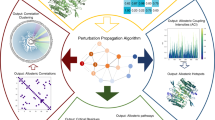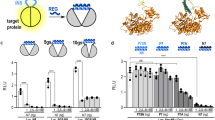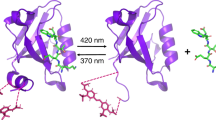Abstract
Allosteric regulation of protein function is a mechanism by which an event in one place of a protein structure causes an effect at another site, much like the behavior of a telecommunications network in which a collection of transmitters, receivers and transceivers communicate with each other across long distances. For example, ligand binding or an amino acid mutation at an allosteric site can alter enzymatic activity or binding affinity in a distal region such as the active site or a second binding site. The mechanism of this site-to-site communication is of great interest, especially since allosteric effects must be considered in drug design and protein engineering. In this review, conformational mobility as the common route between allosteric regulation and catalysis is discussed. We summarize recent experimental data and the resulting insights into allostery within proteins, and we discuss the nature of future studies and the new applications that may result from increased understanding of this regulatory mechanism.
This is a preview of subscription content, access via your institution
Access options
Subscribe to this journal
Receive 12 print issues and online access
$259.00 per year
only $21.58 per issue
Buy this article
- Purchase on Springer Link
- Instant access to full article PDF
Prices may be subject to local taxes which are calculated during checkout







Similar content being viewed by others
Accession codes
References
Monod, J., Wyman, J. & Changeux, J.P. On the nature of allosteric transitions: a plausible model. J. Mol. Biol. 12, 88–118 (1965).
Kuriyan, J. & Eisenberg, D. The origin of protein interactions and allostery in colocalization. Nature 450, 983–990 (2007).
Boehr, D.D., McElheny, D., Dyson, H.J. & Wright, P.E. The dynamic energy landscape of dihydrofolate reductase catalysis. Science 313, 1638–1642 (2006).
Loria, J.P., Berlow, R.B. & Watt, E.D. Characterization of enzyme motions by solution NMR relaxation dispersion. Acc. Chem. Res. 41, 214–221 (2008).
Watt, E.D., Shimada, H., Kovrigin, E.L. & Loria, J.P. The mechanism of rate-limiting motions in enzyme function. Proc. Natl. Acad. Sci. USA 104, 11981–11986 (2007).
Henzler-Wildman, K. & Kern, D. Dynamic personalities of proteins. Nature 450, 964–972 (2007).
Henzler-Wildman, K.A. et al. A hierarchy of timescales in protein dynamics is linked to enzyme catalysis. Nature 450, 913–916 (2007).
Swain, J.F. & Gierasch, L.M. The changing landscape of protein allostery. Curr. Opin. Struct. Biol. 16, 102–108 (2006).
Agarwal, P.K., Billeter, S.R., Rajagopalan, P.T.R., Benkovic, S.J. & Hammes-Schiffer, S. Network of coupled promoting motions in enzyme catalysis. Proc. Natl. Acad. Sci. USA 99, 2794–2799 (2002).
Böde, C. et al. Network analysis of protein dynamics. FEBS Lett. 581, 2776–2782 (2007).
Süel, G.M., Lockless, S.W., Wall, M.A. & Ranganathan, R. Evolutionarily conserved networks of residues mediate allosteric communication in proteins. Nat. Struct. Biol. 10, 59–69 (2003).
Cooper, A. & Dryden, D.T.F. Allostery without conformational change. A plausible model. Eur. Biophys. J. 11, 103–109 (1984).
Gunasekaran, K., Ma, B. & Nussinov, R. Is allostery an intrinsic property of all dynamic proteins? Proteins 57, 433–443 (2004).
Kern, D. & Zuiderweg, E.R.P. The role of dynamics in allosteric regulation. Curr. Opin. Struct. Biol. 13, 748–757 (2003).
Bosco, D.A. & Kern, D. Catalysis and binding of cyclophilin A with different HIV-1 capsid constructs. Biochemistry 43, 6110–6119 (2004).
Bosco, D.A., Eisenmesser, E.Z., Pochapsky, S., Sundquist, W.I. & Kern, D. Catalysis of cis/trans isomerization in native HIV-1 capsid by human cyclophilin A. Proc. Natl. Acad. Sci. USA 99, 5247–5252 (2002).
Cole, R. & Loria, J.P. Evidence for flexibility in the function of ribonuclease A. Biochemistry 41, 6072–6081 (2002).
Louis, J.M., Ishima, R., Torchia, D.A. & Weber, I.T. HIV-1 protease: structure, dynamics, and inhibition. Adv. Pharmacol. 55, 261–298 (2007).
Katoh, E. et al. A solution NMR study of the binding kinetics and the internal dynamics of an HIV-1 protease-substrate complex. Protein Sci. 12, 1376–1385 (2003).
Freedberg, D.I. et al. Rapid structural fluctuations of the free HIV protease flaps in solution: relationship to crystal structures and comparison with predictions of dynamics calculations. Protein Sci. 11, 221–232 (2002).
Massi, F., Wang, C. & Palmer, A.G. III. Solution NMR and computer simulation studies of active site loop motion in triosephosphate isomerase. Biochemistry 45, 10787–10794 (2006).
Benkovic, S.J., Hammes, G.G. & Hammes-Schiffer, S. Free-energy landscape of enzyme catalysis. Biochemistry 47, 3317–3321 (2008).
Osborne, M.J., Schnell, J., Benkovic, S.J., Dyson, H.J. & Wright, P.E. Backbone dynamics in dihydrofolate reductase complexes: role of loop flexibility in the catalytic mechanism. Biochemistry 40, 9846–9859 (2001).
Henzler-Wildman, K.A. et al. Intrinsic motions along an enzymatic reaction trajectory. Nature 450, 838–844 (2007).
Brath, U., Akke, M., Yang, D., Kay, L.E. & Mulder, F.A. Functional dynamics of human FKBP12 revealed by methyl 13C rotating frame relaxation dispersion NMR spectroscopy. J. Am. Chem. Soc. 128, 5718–5727 (2006).
Mulder, F.A., Hon, B., Mittermaier, A., Dahlquist, F.W. & Kay, L.E. Slow internal dynamics in proteins: application of NMR relaxation dispersion spectroscopy to methyl groups in a cavity mutant of T4 lysozyme. J. Am. Chem. Soc. 124, 1443–1451 (2002).
Choy, W.Y. et al. Distribution of molecular size within an unfolded state ensemble using small-angle X-ray scattering and pulse field gradient NMR techniques. J. Mol. Biol. 316, 101–112 (2002).
Hilser, V.J. & Thompson, E.B. Intrinsic disorder as a mechanism to optimize allosteric coupling in proteins. Proc. Natl. Acad. Sci. USA 104, 8311–8315 (2007).
Luque, I., Leavitt, S.A. & Freire, E. The linkage between protein folding and functional cooperativity: two sides of the same coin? Annu. Rev. Biophys. Biomol. Struct. 31, 235–256 (2002).
Daily, M.D. & Gray, J.J. Local motions in a benchmark of allosteric proteins. Proteins 67, 385–399 (2007).
Weber, G. Ligand binding and internal equilibria in proteins. Biochemistry 11, 864–878 (1972).
Freire, E. Can allosteric regulation be predicted from structure? Proc. Natl. Acad. Sci. USA 97, 11680–11682 (2000).
Chennubhotla, C., Yang, Z. & Bahar, I. Coupling between global dynamics and signal transduction pathways: a mechanism of allostery for chaperonin GroEL. Mol. Biosyst. 4, 287–292 (2008).
Amaro, R.E., Sethi, A., Myers, R.S., Davisson, V.J. & Luthey-Schulten, Z.A. A network of conserved interactions regulates the allosteric signal in a glutamine amidotransferase. Biochemistry 46, 2156–2173 (2007).
Masterson, L.R., Mascioni, A., Traaseth, N.J., Taylor, S.S. & Veglia, G. Allosteric cooperativity in protein kinase A. Proc. Natl. Acad. Sci. USA 105, 506–511 (2008).
Rakauskaite, R. & Dinman, J.D. rRNA mutants in the yeast peptidyltransferase center reveal allosteric information networks and mechanisms of drug resistance. Nucleic Acids Res. 36, 1497–1507 (2008).
Torres, M., Fernandez-Fuentes, N., Fiser, A. & Casadevall, A. Exchanging murine and human immunoglobulin constant chains affects the kinetics and thermodynamics of antigen binding and chimeric antibody autoreactivity. PLoS ONE 2, E1310 (2007).
Daily, M.D., Upadhyaya, T.J. & Gray, J.J. Contact rearrangements form coupled networks from local motions in allosteric proteins. Proteins 71, 455–466 (2008).
Niu, X. et al. Interesting structural and dynamical behaviors exhibited by the AF-6 PDZ domain upon Bcr peptide binding. Biochemistry 46, 15042–15053 (2007).
Ricketson, D., Hostick, U., Fang, L., Yamamoto, K.R. & Darimont, B.D. A conformational switch in the ligand-binding domain regulates the dependence of the glucocorticoid receptor on Hsp90. J. Mol. Biol. 368, 729–741 (2007).
Cameron, C.E. & Benkovic, S.J. Evidence for a functional role of the dynamics of glycine-121 of Escherichia coli dihydrofolate reductase obtained from kinetic analysis of a site-directed mutant. Biochemistry 36, 15792–15800 (1997).
Gandhi, P.S., Chen, Z., Mathews, F.S. & Di Cera, E. Structural identification of the pathway of long-range communication in an allosteric enzyme. Proc. Natl. Acad. Sci. USA 105, 1832–1837 (2008).
Lee, M., Chan, C.W., Mitchell Guss, J., Christopherson, R.I. & Maher, M.J. Dihydroorotase from Escherichia coli: loop movement and cooperativity between subunits. J. Mol. Biol. 348, 523–533 (2005).
Heddle, J.G. et al. Dynamic allostery in the ring protein TRAP. J. Mol. Biol. 371, 154–167 (2007).
Yu, P., Lasagna, M., Pawlyk, A.C., Reinhart, G.D. & Pettigrew, D.W. IIAGlc inhibition of glycerol kinase: a communications network tunes protein motions at the allosteric site. Biochemistry 46, 12355–12365 (2007).
Sadovsky, E. & Yifrach, O. Principles underlying energetic coupling along an allosteric communication trajectory of a voltage-activated K+ channel. Proc. Natl. Acad. Sci. USA 104, 19813–19818 (2007).
Piper, D.R., Rupp, J., Sachse, F.B., Sanguinetti, M.C. & Tristani-Firouzi, M. Cooperative interactionis between R531 and acidic residues in the voltage sensing module of hERG1 channels. Cell. Physiol. Biochem. 21, 37–46 (2008).
Ferguson, A.D. et al. Signal transduction pathway of TonB-dependent transporters. Proc. Natl. Acad. Sci. USA 104, 513–518 (2007).
Hatley, M.E., Lockless, S.W., Gibson, S.K., Gilman, A.G. & Ranganathan, R. Allosteric determinants in guanine nucleotide-binding proteins. Proc. Natl. Acad. Sci. USA 100, 14445–14450 (2003).
Lockless, S.W. & Ranganathan, R. Evolutionarily conserved pathways of energetic connectivity in protein families. Science 286, 295–299 (1999).
Shulman, A.I., Larson, C., Mangelsdorf, D.J. & Ranganathan, R. Structural determinants of allosteric ligand activation in RXR heterodimers. Cell 116, 417–429 (2004).
Chi, C.N. et al. Reassessing a sparse energetic network within a single protein domain. Proc. Natl. Acad. Sci. USA 105, 4679–4684 (2008).
Ferguson, A.D. & Deisenhofer, J. Metal import through microbial membranes. Cell 116, 15–24 (2004).
Popovych, N., Sun, S., Ebright, R.H. & Kalodimos, C.G. Dynamically driven protein allostery. Nat. Struct. Mol. Biol. 13, 831–838 (2006).
Alfano, C. et al. Structural analysis of cooperative RNA binding by the La motif and central RRM domain of human La protein. Nat. Struct. Mol. Biol. 11, 323–329 (2004).
Bonaccio, M., Ghaderi, N., Borchardt, D. & Dunn, M.F. Insulin allosteric behavior: detection, identification, and quantification of allosteric states via 19F NMR. Biochemistry 44, 7656–7668 (2005).
Li, Z. et al. A mutation in the S-switch region of the Runt domain alters the dynamics of an allosteric network responsible for CBFbeta regulation. J. Mol. Biol. 364, 1073–1083 (2006).
Abu-Abed, M., Das, R., Wang, L. & Melacini, G. Definition of an electrostatic relay switch critical for the cAMP-dependent activation of protein kinase A as revealed by the D170A mutant of RIalpha. Proteins 69, 112–124 (2007).
Budiman, M.E., Knaggs, M.H., Fetrow, J.S. & Alexander, R.W. Using molecular dynamics to map interaction networks in an aminoacyl-tRNA synthetase. Proteins 68, 670–689 (2007).
Zhuravleva, A. et al. Propagation of dynamic changes in barnase upon binding of barstar: an NMR and computational study. J. Mol. Biol. 367, 1079–1092 (2007).
Salvesen, G.S. & Riedl, S.J. Caspase inhibition, specifically. Structure 15, 513–514 (2007).
Schweizer, A. et al. Inhibition of caspase-2 by a designed ankyrin repeat protein: specificity, structure, and inhibition mechanism. Structure 15, 625–636 (2007).
Bertrand, D. & Gopalakrishnan, M. Allosteric modulation of nicotinic acetylcholine receptors. Biochem. Pharmacol. 74, 1155–1163 (2007).
Raddatz, R., Schaffhauser, H. & Marino, M.J. Allosteric approaches to the targeting of G-protein-coupled receptors for novel drug discovery: a critical assessment. Biochem. Pharmacol. 74, 383–391 (2007).
Ross, R.A. Allosterism and cannabinoid CB1 receptors: the shape of things to come. Trends Pharmacol. Sci. 28, 567–572 (2007).
Shi, Z., Resing, K.A. & Ahn, N.G. Networks for the allosteric control of protein kinases. Curr. Opin. Struct. Biol. 16, 686–692 (2006).
Hardy, J.A. & Wells, J.A. Searching for new allosteric sites in enzymes. Curr. Opin. Struct. Biol. 14, 706–715 (2004).
Liu, J. & Nussinov, R. Allosteric effects in the marginally stable von Hippel-Lindau tumor suppressor protein and allostery-based rescue mutant design. Proc. Natl. Acad. Sci. USA 105, 901–906 (2008).
Erlanson, D.A., Wells, J.A. & Braisted, A.C. Tethering: fragment-based drug discovery. Annu. Rev. Biophys. Biomol. Struct. 33, 199–223 (2004).
Pargellis, C. et al. Inhibition of p38 MAP kinase by utilizing a novel allosteric binding site. Nat. Struct. Biol. 9, 268–272 (2002).
Montalban, A.G. et al. The design and synthesis of novel alpha-ketoamide-based p38 MAP kinase inhibitors. Bioorg. Med. Chem. Lett. 18, 1772–1777 (2008).
Zhang, X.-Y. & Bishop, A.C. Site-specific incorporation of allosteric-inhibition sites in a protein tyrosine phosphatase. J. Am. Chem. Soc. 129, 3812–3813 (2007).
Ostermeier, M. Engineering allosteric protein switches by domain insertion. Protein Eng. Des. Sel. 18, 359–364 (2005).
Dueber, J.E., Mirsky, E.A. & Lim, W.A. Engineering synthetic signaling proteins with ultrasensitive input/output control. Nat. Biotechnol. 25, 660–662 (2007).
Dueber, J.E., Yeh, B.J., Chak, K. & Lim, W.A. Reprogramming control of an allosteric signaling switch through modular recombination. Science 301, 1904–1908 (2003).
Guntas, G., Mitchell, S.F. & Ostermeier, M. A molecular switch created by in vitro recombination of nonhomologous genes. Chem. Biol. 11, 1483–1487 (2004).
Sathyapriya, R. & Vishveshwara, S. Structure networks of E. coli glutaminyl-tRNA synthetase: effects of ligand binding. Proteins 68, 541–550 (2007).
Kendrew, J.C. et al. A three-dimensional model of the myoglobin molecule obtained by x-ray analysis. Nature 181, 662–666 (1958).
Pardee, A.B. & Reddy, G.P. Beginnings of feedback inhibition, allostery, and multi-protein complexes. Gene 321, 17–23 (2003).
Koshland, D.E. Jr., Nemethy, G. & Filmer, D. Comparison of experimental binding data and theoretical models in proteins containing subunits. Biochemistry 5, 365–385 (1966).
Bryngelson, J.D. & Wolynes, P.G. Spin glasses and the statistical mechanics of protein folding. Proc. Natl. Acad. Sci. USA 84, 7524–7528 (1987).
Acknowledgements
We thank S. Hammes-Schiffer for helpful discussions.
Author information
Authors and Affiliations
Corresponding author
Rights and permissions
About this article
Cite this article
Goodey, N., Benkovic, S. Allosteric regulation and catalysis emerge via a common route. Nat Chem Biol 4, 474–482 (2008). https://doi.org/10.1038/nchembio.98
Published:
Issue Date:
DOI: https://doi.org/10.1038/nchembio.98
This article is cited by
-
Insight into de-regulation of amino acid feedback inhibition: a focus on structure analysis method
Microbial Cell Factories (2023)
-
Repurposing conformational changes in ANL superfamily enzymes to rapidly generate biosensors for organic and amino acids
Nature Communications (2023)
-
Effector-dependent structural transformation of a crystalline framework with allosteric effects on molecular recognition ability
Nature Communications (2023)
-
Allosteric rescue of catalytically impaired ATP phosphoribosyltransferase variants links protein dynamics to active-site electrostatic preorganisation
Nature Communications (2022)
-
Identification of allosteric fingerprints of alpha-synuclein aggregates in matrix metalloprotease-1 and substrate-specific virtual screening with single molecule insights
Scientific Reports (2022)



